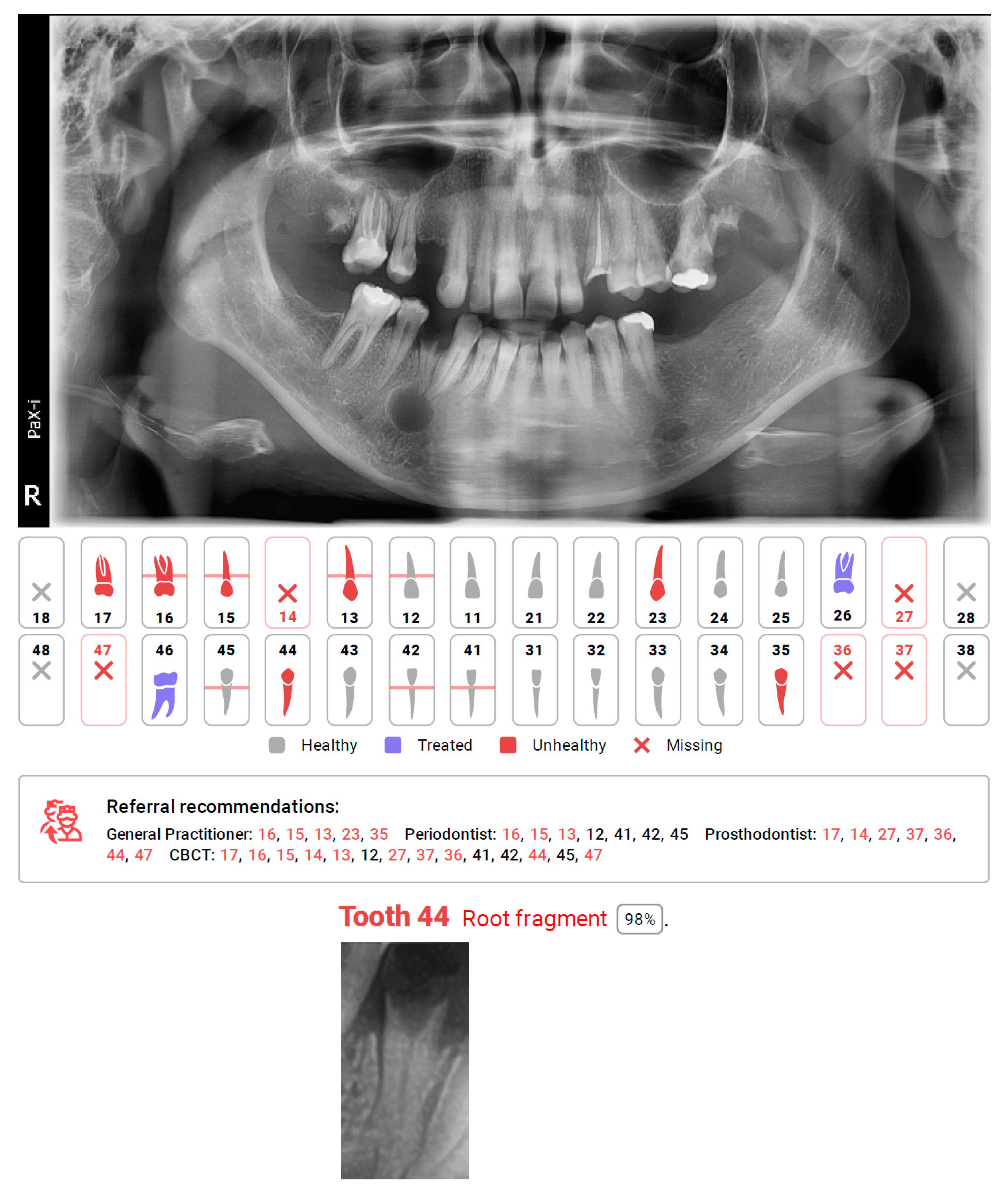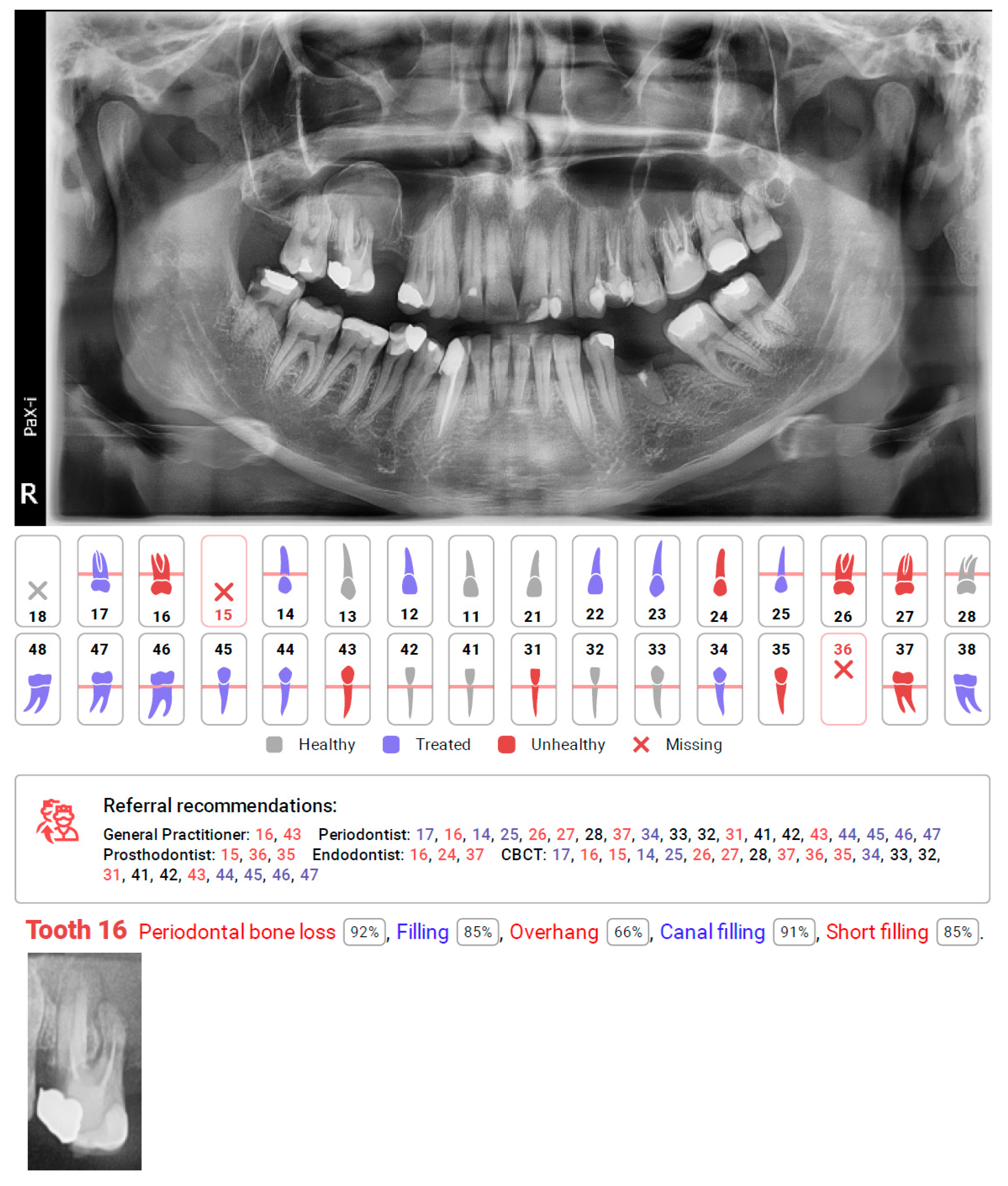Artificial Intelligence Application in Assessment of Panoramic Radiographs
Abstract
:1. Introduction
2. Materials and Methods
3. Results
4. Discussion
5. Conclusions
Author Contributions
Funding
Institutional Review Board Statement
Informed Consent Statement
Data Availability Statement
Acknowledgments
Conflicts of Interest
References
- Cosson, J. Interpreting an orthopantomogram. Aust. J. Gen. Pract. 2020, 49, 550–555. [Google Scholar] [CrossRef]
- Vinayahalingam, S.; Goey, R.S.; Kempers, S.; Schoep, J.; Cherici, T.; Moin, D.A.; Hanisch, M. Automated chart filing on panoramic radiographs using deep learning. J. Dent. 2021, 115, 103864. [Google Scholar] [CrossRef]
- Chan, M.; Dadul, T.; Langlais, R.; Russell, D.; Ahmad, M. Accuracy of extraoral bite-wing radiography in detecting proximal caries and crestal bone loss. J. Am. Dent. Assoc. 2018, 149, 51–58. [Google Scholar] [CrossRef]
- Vandenberghe, B.; Jacobs, R.; Bosmans, H. Modern dental imaging: A review of the current technology and clinical applications in dental practice. Eur. Radiol. 2010, 20, 2637–2655. [Google Scholar] [CrossRef]
- White, S.C.; Pharoah, M.J. Oral Radiology-E-Book: Principles and Interpretation; Elsevier Health Sciences: Amsterdam, The Netherlands, 2014. [Google Scholar]
- Oz, U.; Orhan, K.; Abe, N. Comparison of linear and angular measurements using two-dimensional conventional methods and three-dimensional cone beam CT images reconstructed from a volumetric rendering program in vivo. Dentomaxillofacial Radiol. 2011, 40, 492–500. [Google Scholar] [CrossRef] [Green Version]
- Farman, A.G.; Scarfe, W.C. Development of imaging selection criteria and procedures should precede cephalometric assessment with cone-beam computed tomography. Am. J. Orthod. Dentofac. Orthop. 2006, 130, 257–265. [Google Scholar] [CrossRef]
- Scarfe, W.C.; Farman, A.G.; Sukovic, P. Clinical applications of cone-beam computed tomography in dental practice. J. -Can. Dent. Assoc. 2006, 72, 75. [Google Scholar]
- Kobayashi, K.; Shimoda, S.; Nakagawa, Y.; Yamamoto, A. Accuracy in measurement of distance using limited cone-beam computerized tomography. Int. J. Oral Maxillofac. Implant. 2004, 19, 19. [Google Scholar]
- Hatcher, D.C.; Dial, C.; Mayorga, C. Cone beam CT for pre-surgical assessment of implant sites. CDA 2003, 31, 825–834. [Google Scholar]
- Miles, D.A. The future of dental and maxillofacial imaging. Dent. Clin. North Am. 2008, 52, 917–928. [Google Scholar] [CrossRef]
- Kandelman, D.; Arpin, S.; Baez, R.J.; Baehni, P.C.; Petersen, P.E. Oral health care systems in developing and developed countries. Periodontol 2000 2012, 60, 98–109. [Google Scholar] [CrossRef]
- Ralls, S.; Cohen, M.; Southard, T. Computer-assisted dental diagnosis. Dent. Clin. North Am. 1986, 30, 695–712. [Google Scholar]
- Ezhov, M.; Gusarev, M.; Golitsyna, M.; Yates, J.M.; Kushnerev, E.; Tamimi, D.; Aksoy, S.; Shumilov, E.; Sanders, A.; Orhan, K. Clinically applicable artificial intelligence system for dental diagnosis with CBCT. Sci. Rep. 2021, 11, 15006. [Google Scholar] [CrossRef]
- Hung, K.; Montalvao, C.; Tanaka, R.; Kawai, T.; Bornstein, M.M. The use and performance of artificial intelligence applications in dental and maxillofacial radiology: A systematic review. Dentomaxillofacial Radiol. 2020, 49, 20190107. [Google Scholar] [CrossRef]
- Mahoor, M.H.; Abdel-Mottaleb, M. Classification and numbering of teeth in dental bitewing images. Pattern Recognit. 2005, 38, 577–586. [Google Scholar] [CrossRef]
- Hosny, A.; Parmar, C.; Quackenbush, J.; Schwartz, L.H.; Aerts, H. Artificial intelligence in radiology. Nat. Rev. Cancer 2018, 18, 500–510. [Google Scholar] [CrossRef]
- Chen, H.; Zhang, K.; Lyu, P.; Li, H.; Zhang, L.; Wu, J.; Lee, C.H. A deep learning approach to automatic teeth detection and numbering based on object detection in dental periapical films. Sci. Rep. 2019, 9, 3840. [Google Scholar] [CrossRef] [Green Version]
- Estai, M.; Tennant, M.; Gebauer, D.; Brostek, A.; Vignarajan, J.; Mehdizadeh, M.; Saha, S. Deep learning for automated detection and numbering of permanent teeth on panoramic images. Dentomaxillofac Radiol. 2021, 50, 20210296. [Google Scholar] [CrossRef]
- Ranschaert, E.; Topff, L.; Pianykh, O. Optimization of Radiology Workflow with Artificial Intelligence. Radiol. Clin. N. Am. 2021, 59, 955–966. [Google Scholar] [CrossRef]
- Chen, Y.W.; Stanley, K.; Att, W. Artificial intelligence in dentistry: Current applications and future perspectives. Quintessence Int. 2020, 51, 248–257. [Google Scholar] [CrossRef]
- Grischke, J.; Johannsmeier, L.; Eich, L.; Griga, L.; Haddadin, S. Dentronics: Towards robotics and artificial intelligence in dentistry. Dent. Mater. 2020, 36, 765–778. [Google Scholar] [CrossRef]
- Kulkarni, S.; Seneviratne, N.; Baig, M.S.; Khan, A.H.A. Artificial Intelligence in Medicine: Where Are We Now? Acad. Radiol 2020, 27, 62–70. [Google Scholar] [CrossRef] [Green Version]
- Loehfelm, T.W. Artificial Intelligence for Quality Improvement in Radiology. Radiol. Clin. North Am. 2021, 59, 1053–1062. [Google Scholar] [CrossRef]
- Schwendicke, F.; Samek, W.; Krois, J. Artificial Intelligence in Dentistry: Chances and Challenges. J. Dent. Res. 2020, 99, 769–774. [Google Scholar] [CrossRef]
- Shan, T.; Tay, F.R.; Gu, L. Application of Artificial Intelligence in Dentistry. J. Dent. Res. 2021, 100, 232–244. [Google Scholar] [CrossRef]
- Steinkamp, J.; Cook, T.S. Basic Artificial Intelligence Techniques: Natural Language Processing of Radiology Reports. Radiol. Clin. North Am. 2021, 59, 919–931. [Google Scholar] [CrossRef]
- Nardi, C.; Calistri, L.; Grazzini, G.; Desideri, I.; Lorini, C.; Occhipinti, M.; Mungai, F.; Colagrande, S. Is panoramic radiography an accurate imaging technique for the detection of endodontically treated asymptomatic apical periodontitis? J. Endod. 2018, 44, 1500–1508. [Google Scholar] [CrossRef]
- Ekert, T.; Krois, J.; Meinhold, L.; Elhennawy, K.; Emara, R.; Golla, T.; Schwendicke, F. Deep learning for the radiographic detection of apical lesions. J. Endod. 2019, 45, 917–922.e915. [Google Scholar] [CrossRef]
- Mol, A.; Van Der Stelt, P. Application of computer-aided image interpretation to the diagnosis of periapical bone lesions. Dentomaxillofacial Radiol. 1992, 21, 190–194. [Google Scholar] [CrossRef]
- Orhan, K.; Bayrakdar, I.; Ezhov, M.; Kravtsov, A.; Özyürek, T. Evaluation of artificial intelligence for detecting periapical pathosis on cone-beam computed tomography scans. Int. Endod. J. 2020, 53, 680–689. [Google Scholar] [CrossRef]
- Patel, S.; Wilson, R.; Dawood, A.; Foschi, F.; Mannocci, F. The detection of periapical pathosis using digital periapical radiography and cone beam computed tomography-part 2: A 1-year post-treatment follow-up. Int. Endod. J. 2012, 45, 711–723. [Google Scholar] [CrossRef]
- Davies, A.; Mannocci, F.; Mitchell, P.; Andiappan, M.; Patel, S. The detection of periapical pathoses in root filled teeth using single and parallax periapical radiographs versus cone beam computed tomography—A clinical study. Int. Endod. J. 2015, 48, 582–592. [Google Scholar] [CrossRef]
- Lee, J.H.; Kim, D.H.; Jeong, S.N. Diagnosis of cystic lesions using panoramic and cone beam computed tomographic images based on deep learning neural network. Oral. Dis. 2020, 26, 152–158. [Google Scholar] [CrossRef]
- Lee, J.-H.; Kim, D.-H.; Jeong, S.-N.; Choi, S.-H. Detection and diagnosis of dental caries using a deep learning-based convolutional neural network algorithm. J. Dent. 2018, 77, 106–111. [Google Scholar] [CrossRef]
- Cantu, A.G.; Gehrung, S.; Krois, J.; Chaurasia, A.; Rossi, J.G.; Gaudin, R.; Elhennawy, K.; Schwendicke, F. Detecting caries lesions of different radiographic extension on bitewings using deep learning. J. Dent. 2020, 100, 103425. [Google Scholar] [CrossRef]
- Prados-Privado, M.; García Villalón, J.; Martínez-Martínez, C.H.; Ivorra, C.; Prados-Frutos, J.C. Dental Caries Diagnosis and Detection Using Neural Networks: A Systematic Review. J. Clin. Med. 2020, 9, 3579. [Google Scholar] [CrossRef]




| Categories | Correctly Diagnosed (True Positive) | Mis-Diagnosed (False Negative) | Over-Diagnosed (False Positive) | Total Assessments | Sensitivity | Specificity |
|---|---|---|---|---|---|---|
| missing tooth | 149 | 6 | 15 | 960 | 0.961 | 0.981 |
| caries | 89 | 111 | 11 | 805 | 0.445 | 0.982 |
| filling | 223 | 45 | 7 | 805 | 0.832 | 0.987 |
| prosthetic restoration (crown or post) | 44 | 2 | 4 | 805 | 0.957 | 0.995 |
| endodontically treated tooth | 95 | 14 | 4 | 805 | 0.872 | 0.994 |
| underfilled canal | 28 | 18 | 0 | 109 | 0.609 | 1.000 |
| overfilled canal | 5 | 6 | 0 | 109 | 0.455 | 1.000 |
| inhomogeneous filling in canal | 4 | 1 | 6 | 109 | 0.800 | 0.942 |
| residual root | 32 | 7 | 1 | 805 | 0.821 | 0.999 |
| periapical lesion (osteolytic, osteosclerotic or mixed) | 23 | 36 | 14 | 805 | 0.390 | 0.981 |
| periodontal bone loss | 189 | 47 | 87 | 805 | 0.801 | 0.847 |
| Categories | ICC Interevaluator |
|---|---|
| missing tooth | 0.977 |
| caries | 0.829 |
| filling | 0.928 |
| prosthetic restoration (crown, post) | 0.984 |
| endodontically treated tooth | 0.989 |
| underfilled canal | 0.924 |
| overfilled canal | 0.886 |
| inhomogeneous filling in canal | 0.834 |
| residual root | 0.969 |
| periapical lesion (osteolytic, osteosclerotic or mixed) | 0.903 |
| periodontal bone loss | 0.842 |
| Groups | ICC Diagnocat/Ground Truth |
|---|---|
| missing tooth | 0.959 |
| carries | 0.681 |
| filling | 0.920 |
| prosthetic restoration (crown, post) | 0.968 |
| endodontically treated tooth | 0.948 |
| underfilled canal | 0.784 |
| overfilled canal | 0.752 |
| inhomogeneous filling in canal | 0.671 |
| residual root | 0.938 |
| periapical lesion (osteolytic, osteosclerotic or mixed) | 0.619 |
| periodontal bone loss | 0.764 |
Publisher’s Note: MDPI stays neutral with regard to jurisdictional claims in published maps and institutional affiliations. |
© 2022 by the authors. Licensee MDPI, Basel, Switzerland. This article is an open access article distributed under the terms and conditions of the Creative Commons Attribution (CC BY) license (https://creativecommons.org/licenses/by/4.0/).
Share and Cite
Zadrożny, Ł.; Regulski, P.; Brus-Sawczuk, K.; Czajkowska, M.; Parkanyi, L.; Ganz, S.; Mijiritsky, E. Artificial Intelligence Application in Assessment of Panoramic Radiographs. Diagnostics 2022, 12, 224. https://doi.org/10.3390/diagnostics12010224
Zadrożny Ł, Regulski P, Brus-Sawczuk K, Czajkowska M, Parkanyi L, Ganz S, Mijiritsky E. Artificial Intelligence Application in Assessment of Panoramic Radiographs. Diagnostics. 2022; 12(1):224. https://doi.org/10.3390/diagnostics12010224
Chicago/Turabian StyleZadrożny, Łukasz, Piotr Regulski, Katarzyna Brus-Sawczuk, Marta Czajkowska, Laszlo Parkanyi, Scott Ganz, and Eitan Mijiritsky. 2022. "Artificial Intelligence Application in Assessment of Panoramic Radiographs" Diagnostics 12, no. 1: 224. https://doi.org/10.3390/diagnostics12010224
APA StyleZadrożny, Ł., Regulski, P., Brus-Sawczuk, K., Czajkowska, M., Parkanyi, L., Ganz, S., & Mijiritsky, E. (2022). Artificial Intelligence Application in Assessment of Panoramic Radiographs. Diagnostics, 12(1), 224. https://doi.org/10.3390/diagnostics12010224








